AUDI S7 2016 Owners Manual
Manufacturer: AUDI, Model Year: 2016, Model line: S7, Model: AUDI S7 2016Pages: 294, PDF Size: 73.82 MB
Page 261 of 294

M N <( I.J "". rl I.O
"' N I.O rl
Taking the wheel off/installing the spare
Follow these instructions step-by-step for chang
ing the wheel.
Fig. 209 Changing a wheel: using the screwdriver handle
(wi th the blade removed) to turn the bolts
Fig. 210 Changing a wheel: alignment pin inside the top
hole
After you have loosened a ll wheel bolts and
raised the vehicle off the ground, remove and re
p lace the whee l as fo llows:
Removing the wheel
.. Use the hexagonal so cket in the screwdriver
handle
to completely remove the topmost
whee l bolt and set it aside on a
clean surface
¢fig. 209.
.. Screw the threaded end of the alignment pin
from the tool kit hand-tight into the empty bolt
hole
¢fig. 210.
.. The n remove the other wheel bo lts as descr ibed
above .
.. Take off the wheel leav ing the alignment pin in
the bo lt hole
¢0.
Putting on the spare wheel
.. Lift the spare wheel and carefully slide it over
the alignment pin to guide it in place
¢0 .
Emergen cy assistance
.. Use the hexagonal socket in the screwdriver
handle to screw in and tighten all whee l bolts
slightly.
.. Remove the alignment pin and insert and tight
en the remaining wheel bolt slightly like the
rest .
.. Turn the jack handle counter-clockwise to lower
the vehicle until the jack is fully re leased .
.. Use the wheel bolt wrench to tighten all wheel
bolts firmly
c;, page 256. Tighten them cross
wise,
from one bolt to the (approximate ly) op
posite one, to keep the whee l centered.
(D Note
When removing or installing the wheel, the
rim could hit the brake roto r and damage the
rotor. Work carefully and have a second per
son help you .
@ Tips
Never use the hexagonal socket in the handle
of the screwdriver to loosen or tighten the
whee l bolts.
- Pull the reversible blade from the screwdriv
er before you use the hexagonal socket in
the handle to turn the whee l bolts.
- When mount ing tires w ith
unidirectional
tread design
make sure the tread pattern is
pointed the right way
c;, page 259.
-The wheel bolts should be clean and easy to
turn. Check for dirt and corrosion on the
mating surfaces of both the wheel and the
hub. Remove all dirt from these surfaces be
fore remounting the wheel.
Tires with unidirectional tread design
Tires with unidirectional tread design must be
mounted with their tread pattern pointed in the
right direction .
Using a spare tire with a tread pattern
intended for use in a specific direction
When using a spare tir e with a tread pattern in
tended for use in a specific direction, please note
the following:
- The direction of rotation is marked by an arrow
on the side of the tire . .,.
259
Page 262 of 294
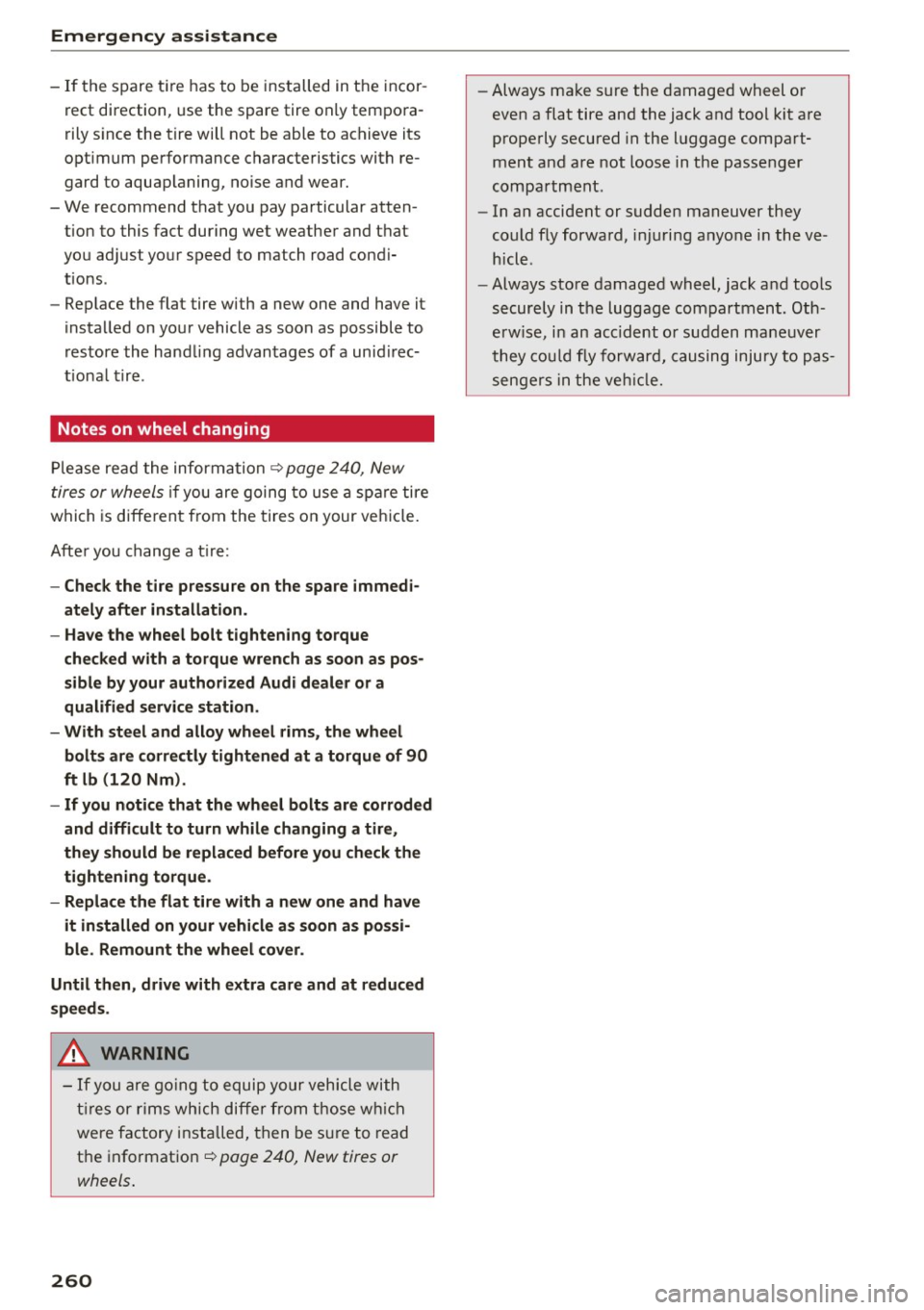
Emergency assistance
-If the spare tire has to be installed in the incor
rect direction, use the spare tire only tempora
rily s ince the tire will not be able to achieve its
optimum performance characteristics with re gard to aquaplaning, noise and wear.
- We recommend that you pay particular atten
tion to this fact during wet weather and that
you adjust your speed to match road condi
tions.
- Replace the flat tire with a new one and have it
installed on your vehicle as soon as possible to
restore the handling advantages of a unid irec
tiona l tire .
Notes on wheel changing
Please read the information r=:> page 240, New
tires or wheels
if you are going to use a spa re tire
which is diffe rent from the tires on your vehicle.
After you change a tire:
-Check the tire pressure on the spare immedi
ately after installation.
- Have the wheel bolt tightening torque
checked with a torque wrench as soon as pos
sible by your authorized Audi dealer or a
qualified service station.
- With steel and alloy wheel rims, the wheel
bolts are correctly tightened at a torque of 90
ft lb (120 Nm).
- If you notice that the wheel bolts are corroded
and difficult to turn while changing a tire,
they should be replaced before you check the
tightening torque.
- Replace the flat tire with a new one and have
it installed on your vehicle as soon as possi
ble. Remount the wheel cover .
Until then, drive with extra care and at reduced
speeds .
.8, WARNING
-If you are going to equip your vehicle with
tires or rims which differ from those which
were factory installed, then be sure to read
the information
r=;, page 240, New tires or
wheels .
260
-
-Always make sure the damaged wheel or
even a flat tire and the jack and tool kit are
properly secured in the luggage compart
ment and are not loose in the passenger
compartment.
- In an accident or sudden maneuver they
could fly forward, injuring anyone in the ve
hicle.
- Always store damaged wheel, jack and tools
securely in the luggage compartment. Oth
erwise, in an accident or sudden maneuver
they could fly forward, causing injury to pas
sengers in the vehicle.
Page 263 of 294
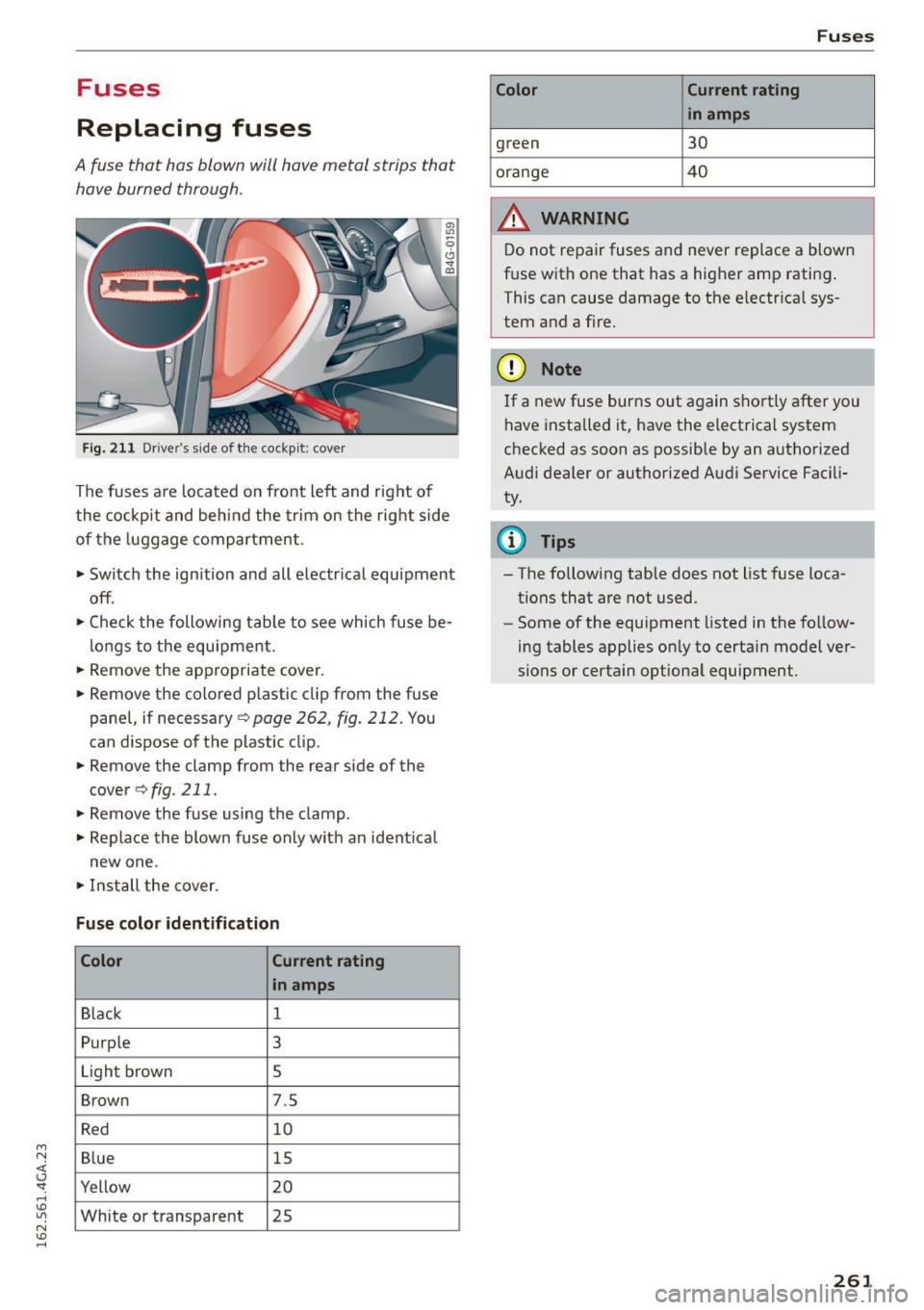
M N <( I.J "". rl I.O
"' N I.O rl
Fuses
Replacing fuses
A fuse that has blown will have metal strips that have burned through.
Fig. 211 Driver's side of the cockpit : cover
The fuses are located on front left and right of
the cockpit and behind the trim on the right side
of the luggage compartment .
• Switch the ign ition and all electr ical equipment
off.
• Check the following table to see which fuse be
longs to the equipment.
• Remove the appropriate cover.
• Remove the colored plastic clip from the fuse
panel, if necessary
q page 262, fig. 212 . You
can dispose of the plastic clip.
• Remove the clamp from the rear side of the
cover qfig .
211.
• Remove the fuse using the clamp.
• Replace the blown fuse only with an ident ica l
new one.
• Install the cover.
Fuse color identification
Color Current rating
in amps
Black 1
Purp le 3
Light brown 5
Brown 7.5
Red 10
Blue 15
Yellow 20
White or transparent 25
Fuses
Color Current rating
in amps
green 30
ora nge 40
,&_ WARNING
= -Do not repair fuses and never replace a blown
fuse with one that has a higher amp rating .
This can cause damage to the e lectr ical sys
tem and a fire.
(D Note
If a new fuse burns out again shortly after you
have installed it, have the electrical system
checked as soon as possible by an authorized
Audi dealer or authorized Audi Service Facili
ty,
Ci) Tips
- The following table does not list fuse loca
tions that are not used.
- Some of the equipment listed in the follow
ing tables applies on ly to certa in model ver
sions or certain optional equipment.
261
Page 264 of 294
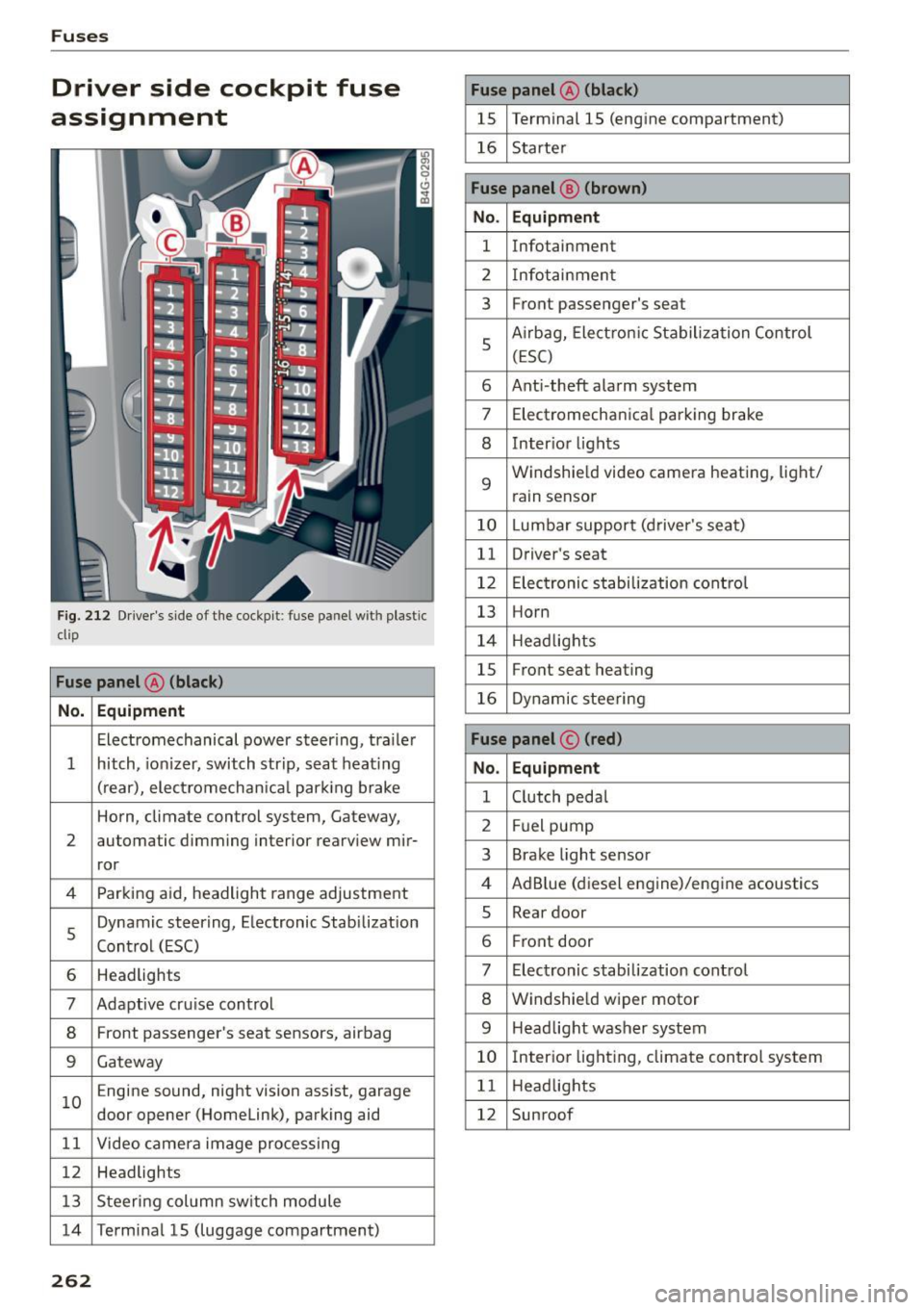
Fuses
Driver side cockpit fuse
assignment
Fig. 212 Driver's side of the cockpit : fuse pa nel w it h plastic
cl ip
Fuse panel @ (black)
No. Equipment
Electromechanical power steer ing, trailer
1 hitch, ionizer, switch strip, seat heating
(rear), electromechanica l park ing brake
Horn, climate control system, Gateway,
2 automatic dimming interior rearview mir-
ror
4 Parking aid, headlight range adjustment
5 Dynamic steering, Electronic Stabilization
Control (ESC)
6 Headlights
7 Adaptive cru
ise control
8 Front passenger's seat sensors, airbag
9 Gateway
10 E
ngine sound, night vision assist, garage
door opener (Homelink), parking aid
11 Video camera image processing
12 Headlights
13 Steering col umn switch module
14 Terminal 15 (luggage compartment)
262
Fuse panel @ (black)
15 Terminal 15 (engine compartment)
16 Starter
Fuse panel @ (brown)
No . Equipment
1 Infotainment
2 Infotainment
3 Front passenger
's seat
5 Airbag, Electron
ic Stabilization Control
(ESC)
6 Anti -theft alarm system
7 Electromechanical parking brake
8 Inter
ior lights
9 Windshie
ld video camera heating , light/
rain sensor
10 Lumbar support (driver's seat)
11 Driver's seat
12 Electronic stabilization control
13 Horn
14 Headlights
15 Front seat heating
16 Dynamic steering
Fuse panel © (red)
No. Equipment
1 Clutch pedal
2 Fuel pump
3 Brake light sensor
4 AdBlue (diesel engine)/engine acoustics
5 Rear door
6 Front
door
7 Electronic stabilization control
8 Windshield wiper motor
9 Headlight washer system
10 Interior lighting, climate control system
11 Headlights
12 Sunroof
Page 265 of 294
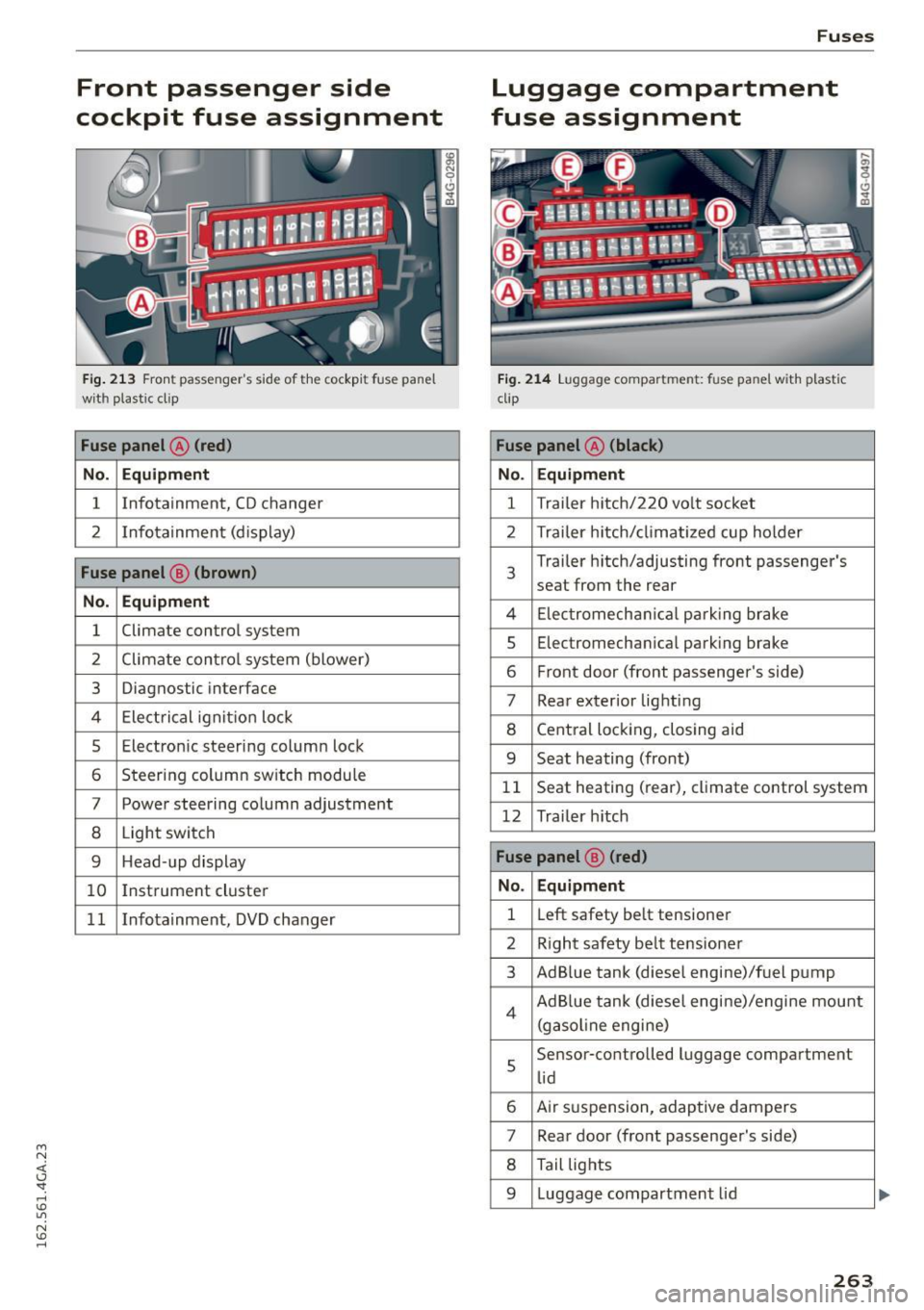
M N <( I.J "". rl I.O
"' N I.O rl
Front passenger side
cockpit fuse assignment
F ig. 21 3 Front passenger 's s ide of t he cockp it fuse pa nel
wit h plast ic cl ip
Fuse panel @ (red)
No. Equipment
1 Infotainment, CD changer
2 I nfotain ment (d isplay)
Fuse panel @ (brown)
No . Equipment
1 Climate control system
2 Climate con
trol sys tem (blower)
3 Diagnostic interface
4 Ele ctric al ignit ion loc k
5 Electro nic steer ing colum n lock
6 Steer ing column sw itch modu le
7 Power steering co lumn adjustment
8 Light switch
9 Head-up display
1 0 I
nstrument cluste r
1 1 Infotainment, DVD changer
Fuses
Luggage compartment
fuse assignment
F ig . 214 Lu ggage compa rtm ent: fuse pa nel w ith plastic
cli p
Fuse panel @ (black)
No. Equipment
1 Trailer h
itch/220 vo lt socket
2 Trailer h itch/ climatize d cup holder
3
Trailer h itch/adjusting front passenger's
seat from the rear
4 El ec tromech anical p ar kin g bra ke
5 Electromecha nica l park ing brake
6 Fr ont door (front passenger 's side)
7 Rear exterior lig hti ng
8 Cent ral loc king, closing aid
9 Seat heating (front)
1 1 Seat heating (rear), climate control system
12 Trailer h itch
Fuse panel @ (r ed)
No. Equipment
1 L
eft safety be lt tensioner
2 R ight safety be lt tensione r
3 AdBlue tank (diesel engine)/f uel p ump
4 Ad B lue tank (diese l engi ne)/engine mount
(g asol ine engine)
s
Sensor -co ntrolled luggage compartment
li d
6 Air s uspension, adaptive dam pers
7 Rear door (fro nt passenge r's side)
8 Tail lig hts
9 Luggage compartment lid
263
Page 266 of 294
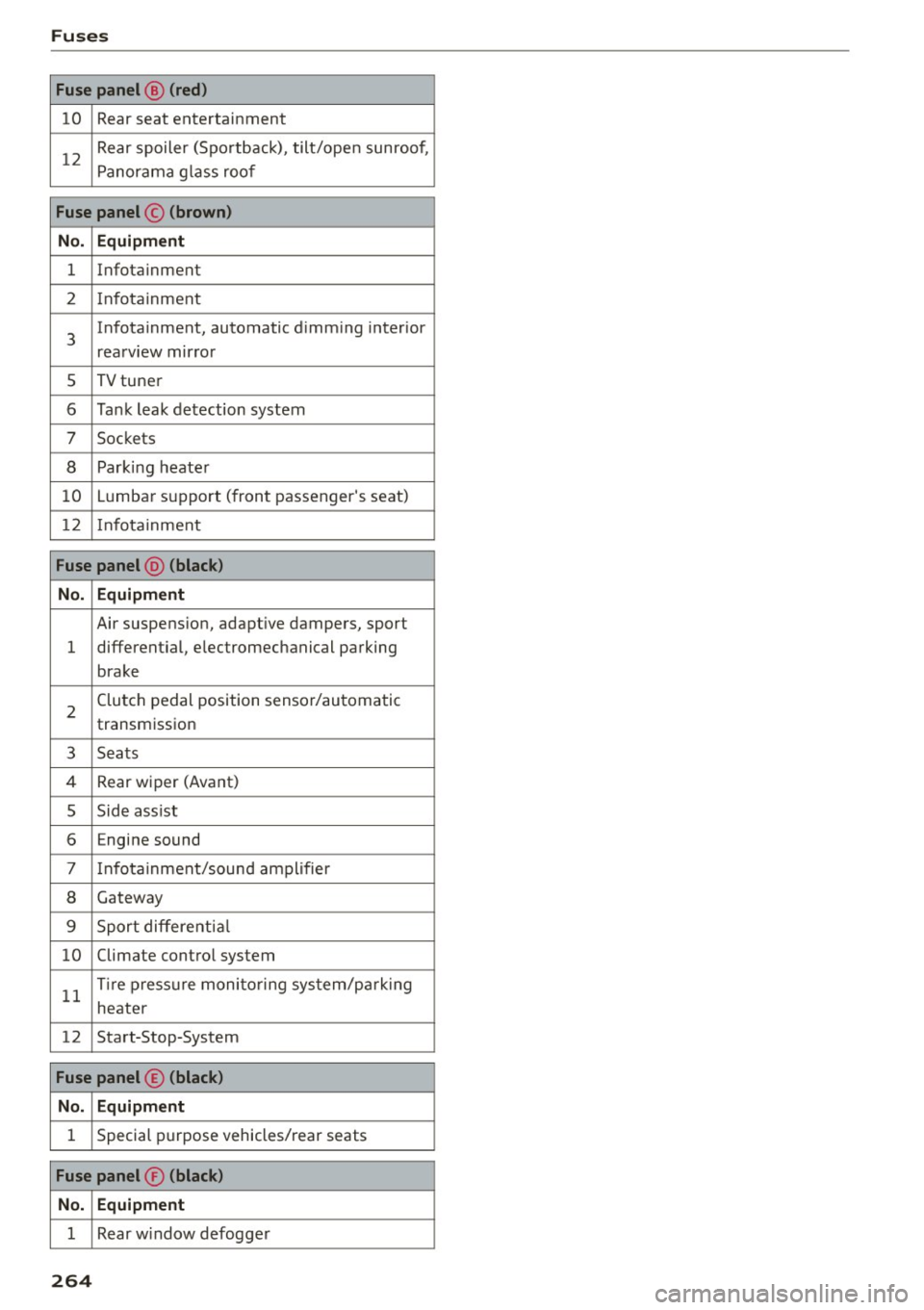
Fuses
Fuse panel® (red)
10 Rear seat entertainment
12
Rear spoiler (Sportback), tilt/open sunroof,
Panorama g lass roof
Fuse panel © (brown)
No. Equipment
1 Infotainment
2 I n fota inment
3
Infotainment , automatic d imm ing interior
rea rview mirro r
s TV tuner
6 Tank leak detection system
7 Sockets
8 Park ing heate r
10 Lu mba r su pport (front passenger's seat)
12 Infota inment
Fuse panel @ (black )
No. Equipm ent
Air suspens io n, adapt ive dampers, sport
l differentia l, e lectr om echanical parking
brake
2
Clu tch pedal position senso r/au tomatic
transmission
3 Seats
4 Rear w iper (Avant)
s Side assist
6 Engine sound
7 Infota inment/sound amplifier
8 Gateway
9 Sport differentia l
10 Climate control system
11
T ire press ure moni to ring sys tem/p ark ing
heater
12 Start-Stop-System
Fuse panel © (black )
No. Equipment
1 Special p urpose vehicles/rear seats
Fuse panel ® (black)
No. Equipment
1 Rear w indow defogge r
264
Page 267 of 294

M N <( (.J
'SI: ,...., \!) 1.1'1
N \!) ,....,
Emergency situations
General
This chapter is intended for trained emergency
crews and working personnel who have the nec
essary tools and equipment to perform the se
operations.
Starting by pushing or
towing
(D Note
Vehicles w ith an automatic transmission can
not be started by push ing o r tow ing.
Starting with jumper
cables
If necessary, the engine can be started by con
necting it to the battery of another vehicle .
If the engine should fail to start because o f a dis
charged or weak battery, the battery can be con
nected to the battery of
another vehicle, us ing a
pair of jumper cables to start the engine .
Jumper cables
Use only jumper cables of sufficiently large cros s
section
to carry the starter current safe ly. Refer
to the manufacturer's specifications.
Use only jumper cables with
insulated term inal
clamps which are distinctly marked:
plus(+) cable in most cases co lored red
minus (-) cable
in most cases colored black .
A WARNING
Batteries contain electricity, acid, and gas .
Any of these can cause very ser ious or fatal in
jury . Fo llow the instructions be low for safe
handling of your vehicle's battery.
- Always shield your eyes and avoid leaning
over the battery whenever possible.
- A discharged battery can freeze at tempera
tures just below 32 °F (0 °C) . Before con
necting a jumper cable, you must thaw the
Emergency situations
frozen battery completely, otherwise it
could explode .
- Do not allow battery acid to contact eyes or
skin. Flush any contacted area with water immediately.
- Improper use of a booster battery to start a
veh icle may cause an explosion.
- Vehicle batteries generate explosive gases .
Keep sparks, flame and lighted cigarettes
away from batteries.
- Do not try to jump start any vehicle with a
low acid level in the battery.
- The voltage of the booster battery must al
so have a 12-volt rating. The capacity (Ah) of
the booster battery should not be lower
than that of the discharged battery. Use of batteries of different voltage or substantial
ly different" Ah" rating may cause an explo
sion and personal injury.
- Never charge a frozen battery . Gas trapped
in the ice may cause an explosion .
- Never charge or use a battery that has been
frozen . The battery case may have be weak
ened ,
- Use of batter ies of different voltage or sub
stantially different capacity (Ah) rating may
cause an exp losion and injury. Th e capacity
(Ah) of the booste r battery should not be
lower than that of the discharged battery.
- Before you check anything in the engine
compartment, always read and heed a ll
WARNINGS
q page 218 .
(D Note
-Applying a h igher voltage booster battery
w ill cause expensive damage to sensitive
electronic components, such as control
units, relays, radio, etc.
- Th ere must be no ele ct rical contact between
the vehicles as otherwise current could al
ready start to flow as soon as the positive
(+) termina ls are connected.
(D Tips
The discharged battery must be properly con-
nected to the vehicle's e lectrical system. .,..
265
Page 268 of 294
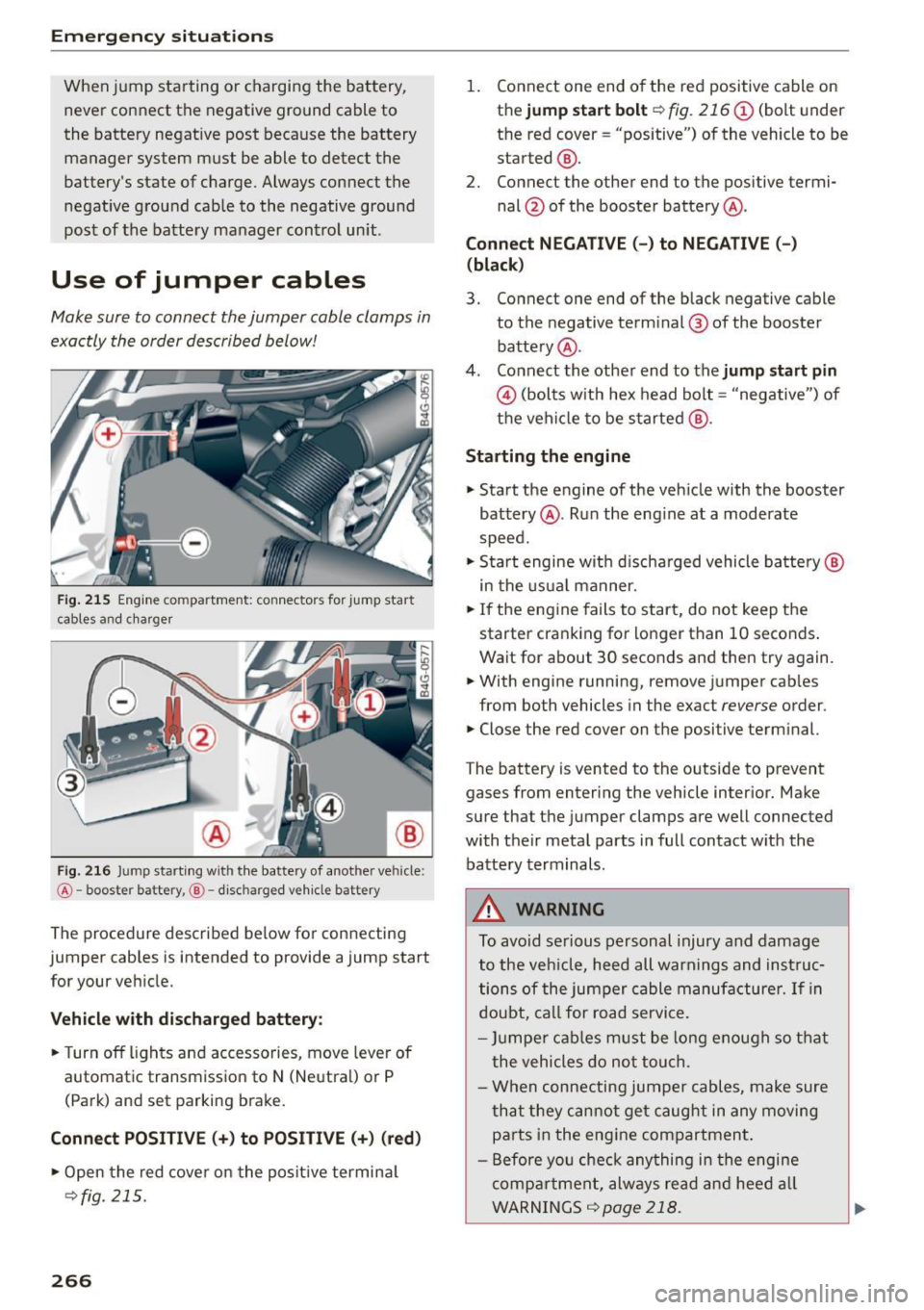
Emergency situation s
When jump sta rting or charging the battery,
never connect the negative ground cable to
the batte ry negat ive post because the battery
manager system must be able to detect the
battery's state of c harge. Always connect the
negat ive grou nd cab le to the negative ground
post of the batte ry manager control unit .
Use of jumper cables
Make sure to connect the jumper cable clamps in
ex actly the order described below!
F ig . 215 Eng ine co m pa rt m ent: con nec tors for ju mp star t
cab les a nd cha rge r
® .--l @
Fig . 2 16 Jum p start ing w it h t he bat te ry of a not her ve hicl e:
@-boos te r ba ttery , @ -disc harg ed v eh icle batt ery
The procedure described be low for con necting
jumper cables is intended to p rovide a jump start
for your ve hicle.
Vehicle with discharged battery: •T urnoff lig ht s and accesso ries , move lever of
automat ic transmiss ion to N (Ne utra l) or P
(Park) and set parking brake.
Connect POSITIVE(+) to POSITIVE(+) (red)
• Open the red cove r o n t he po sit ive termin al
~fig . 2 15.
266
1. Connect one end o f the red positive ca ble on
the
jump start bolt ~ fig. 216 /J) (bolt under
the red cover = "positive") of the vehicle to be
started @.
2. Connect the other end to the positive termi-
nal@ of the booster battery @.
Connect NEGATIVE (-) to NEGATIVE (-)
(black )
3. Co nnect one end of the black negative cable
to the negative term inal ® of the booste r
batte ry @ .
4 . Connect th e other end to the
jump start pin
@ (bolts w it h hex head bolt = "negative") of
the veh icle to be s tarte d@ .
Starting the engine • Sta rt the engine of the veh icle with the booster
bat tery @. Run the eng ine at a moderate
speed.
• Sta rt engine w it h discha rged vehicle ba ttery @
i n t he usual man ner.
• If the engine fails to start, do not keep the
starter cra nking for lo nger than 10 seco nds .
Wait for about 30 seconds and then try again .
• With engine running , remove jumper cab les
from both vehicles in the exact
reverse order .
• Close the red cover on the positive term inal.
The batt ery is vented to the o utside to prevent
gases from enter ing the vehicle inter ior. Make
su re that t he jumper clamps are well connected
with their metal parts in full contact w ith the
batte ry terminals.
&_ WARNING
To avoid se rious personal injury and damage
to the veh icle, heed all war nings and inst ruc
tion s of the jumper cable m anufa cture r.
If in
d oubt, cal l for ro ad service.
- Ju mpe r cabl es must be lo ng enoug h so tha t
t he vehicles do no t tou ch.
- When conne cting jumper cables, make sure
th at they c an not get c aug ht in any moving
p art s in the engine com partmen t.
- B efore you check any thing in the e ngine
comp artment, alw ays re ad an d hee d all
WAR NINGS
~ page 218.
Page 269 of 294
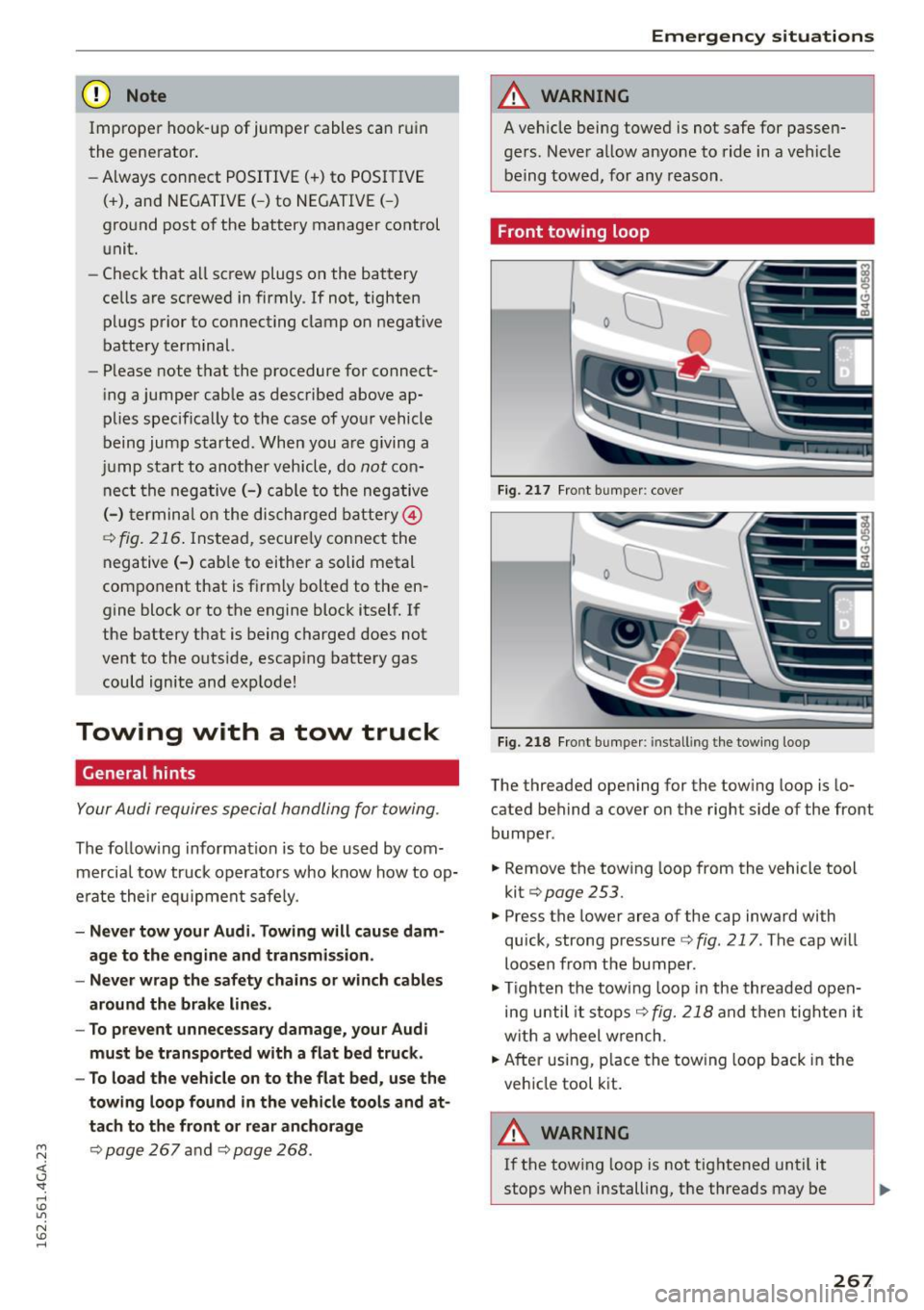
M N <( I.J "". rl I.O
"' N I.O rl
(D Note
Improper hook-up of jumper cables can ruin
the generator.
- Always connect POSITIVE( +) to POSITIVE
( + ), and NEGATIVE( -) to NEGATIVE(-)
ground post of the battery manager control
unit.
- Check that all screw plugs on the battery
cells are screwed in firmly. If not, tighten
plugs prior to connecting clamp on negative
battery terminal.
- Please note that the procedure for connect
ing a jumper cable as described
above ap
plies specifically to the case of your vehicle
being jump started. When you are giving a
jump sta rt to another vehicle, do
not con
nect the negative(-) cab le to the negative
( - ) terminal on the discharged battery @
r:::;, fig. 216. Instead, secure ly connect the
negative(-) cab le to either a solid metal
component that is firm ly bolted to the en
gine block or to the engine block itself. If
the battery that is being charged does not
vent to the outs ide, escap ing battery gas
could ignite and explode!
Towing with a tow truck
General hints
Your Audi requires special handling for towing.
The follow ing information is to be used by com
mercial tow truck operators who know how to op
erate their eq uipment safe ly.
- Never t ow your Audi. To wing will cau se da m
age to the engine and tran smi ssion .
- Neve r wrap th e safety cha in s or win ch cab le s
around the brake line s.
- To pre vent unnecess ary dama ge, your A udi
mu st b e trans port ed w ith a fl at b ed t ru ck .
- To lo ad the vehicle on to th e flat bed, us e the
towing l oop found in th e vehicle tool s and at
tach to th e fr ont or re a r anc hora ge
¢ page 267 and ¢page 268.
Emergen cy situati ons
A WARNING
-A veh icle being towed is not safe for passen-
gers. Neve r all ow anyone to ride in a vehicle
being towed, for any reason .
Front towing loop
Fig. 217 Fro nt bumper: cover
Fig . 2 18 Fro nt bumper : insta lling the tow ing loop
The threaded opening for the towing loop is lo
cated behind a
cover on the right side of the front
bumper .
.,. Remove the towing loop from the vehicle tool
kit¢
page 253.
.,. Press the lower area of the cap inward with
quick, strong pressure
r::;, fig . 217 . The cap w ill
loosen from the bumper .
.,. Tighten the towing loop in the threaded open
ing until it stops
¢ fig. 218 and then tighten it
w ith a wheel wrench .
.,. After using, p lace the towing loop back in the
vehicle tool k it.
A WARNING
--
If the towing loop is not tightened until it
stops when installing, the threads may be
267
Page 270 of 294
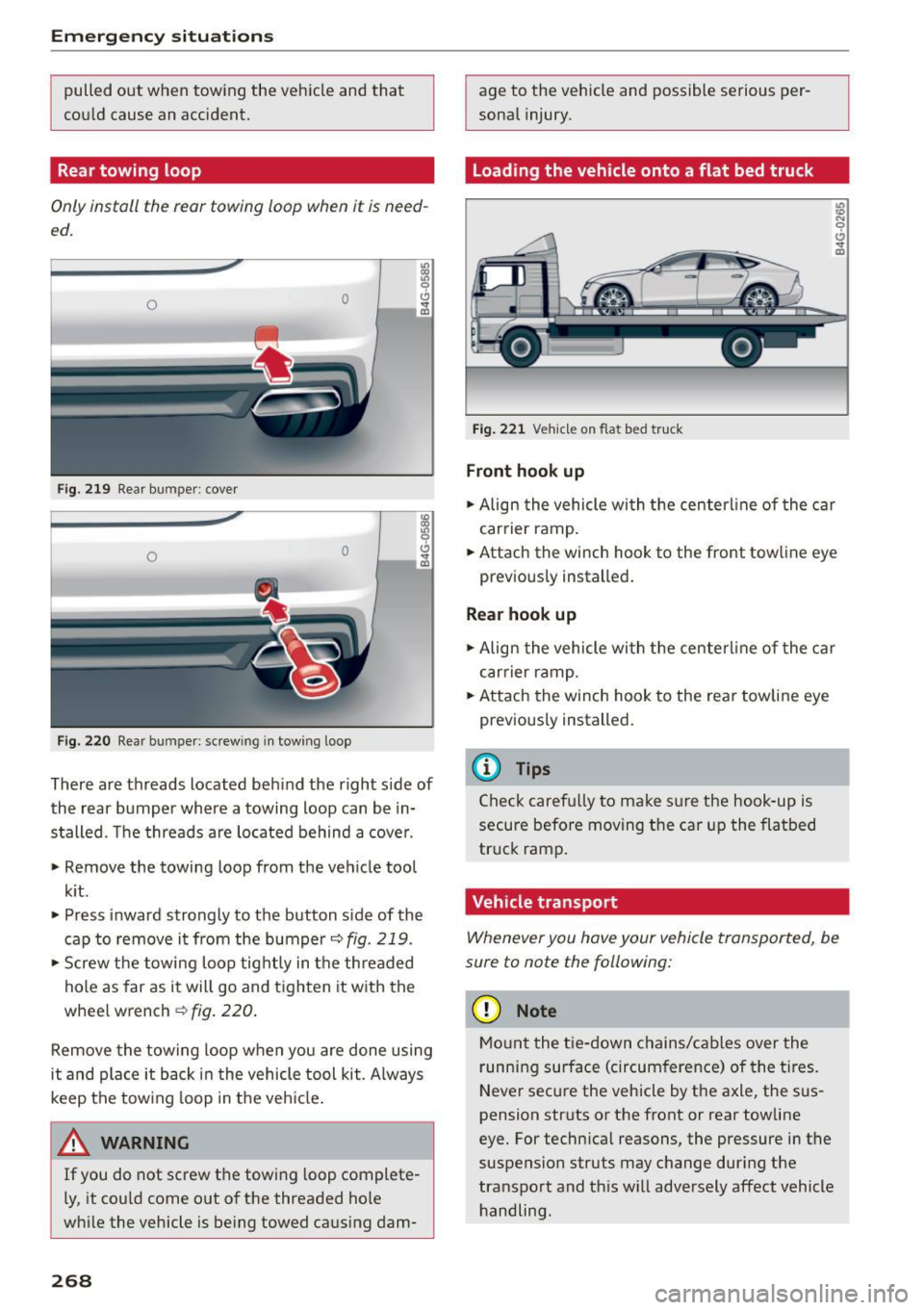
Emergency situations
pulled out when towing the vehicle and that
could cause an accident.
Rear towing loop
Only install the rear towing loop when it is need
ed.
0 0
Fig. 219 Rear bumper: c over
0 0
Fig. 220 Rear bump er: sc rew ing in towing loop
There are threads located behind the right side of
the rear bumper where a towing loop can be in
stalled. The threads are located behind a cover.
" Remove the towing loop from the vehicle tool
kit .
.. Press inward strongly to the button side of the
cap to remove it from the bumper
r=;,fig. 219 .
"Screw the towing loop tightly in the threaded
hole as far as it will go and tighten it with the
wheel wrench
r=;, fig. 220.
Remove the towing loop when you are done using
it and place it back in the vehicle tool kit . Always
keep the towing loop in the vehicle.
&_ WARNING
If you do not screw the towing loop complete
ly, it could come out of the threaded hole
while the vehicle is being towed causing dam·
268
age to the vehicle and possible serious per
sonal injury .
Loading the vehicle onto a flat bed truck
Fig. 221 Vehicle on flat bed tru ck
Front hook up
:g N 0 t!, .., m
"Align the vehicle with the centerline of the car
carrier ramp .
.. Attach the w inch hook to the front towline eye
previously installed.
Rear hook up
"Align the vehicle with the centerline of the car
carrier ramp .
.. Attach the winch hook to the rear towline eye
previously installed.
@ Tips
Check carefully to make sure the hook-up is
secure before moving the car up the flatbed
truck ramp.
Vehicle transport
Whenever you hove your vehicle transported, be
sure to note the following:
(D Note
Mount the tie-down chains/cables over the
running surface (circumference) of the tires.
Never secure the vehicle by the axle, the sus
pension struts or the front or rear towline
eye. For technical reasons, the pressure in the
suspension struts may change during the
transport and this will adversely affect vehicle handling.